

“Our Lenten
Journey: The Judgment Hall”
Acts 2:22-24
Pastor Kevin Vogts
Trinity Lutheran Church
Paola, Kansas
Lent Service III—March 16, 2022
Grace to you and peace from God our Father and the Lord
Jesus Christ. Amen.
The theme for our Wednesday sermons during Lent this year is “Our
Lenten Journey,” focusing on the locations of Christ’s final sufferings and
death. So far we’ve looked at “The Upper Room” and “The Garden of
Gethsemane.” This evening we continue with “The Judgment Hall.”
There’s a regular feature in Reader’s Digest called “That’s
Outrageous,” often featuring examples of criminals who go free or get unjustly
light sentences. The story of Christ’s crucifixion is the most outrageous
example of injustice in all human history. For Jesus Christ was totally
without any wrongdoing, even without any sin, perfectly innocent and holy—the
only person in history you can say that about.
The Gospels record that in a span of less than ten hours Jesus appeared
before
four different human judges, tribunals, and interrogators, and every
one of them condemned him to death or allowed him to be put to death. That
Book of Acts records that looking back on those events 50 days later, Peter said
to the crowd at Pentecost:
“Men of Israel, listen to this: Jesus of Nazareth was a man accredited
by God to you by miracles, wonders and signs, which God did among you through
him, as you yourselves know. This man was handed over to you by God’s set
purpose and foreknowledge; and you, with the help of wicked men, put him to
death by nailing him to the cross.”
God foreknew the wickedness of humankind, and how in accordance with
God’s eternal plan of salvation his Son would suffer under Pontius Pilate and be
crucified, dead, and buried. Tonight we consider how Christ’s unjust
condemnation in the judgment halls of men earned you freedom from condemnation
before the judgment throne of Christ.
Point #1) In the Judgment Hall of Materialism
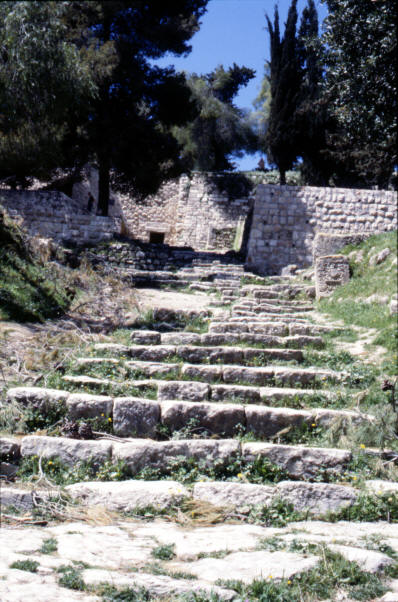
It all began with the arrest of Jesus in the Garden of Gethsemane at
about 11:00pm on Maundy Thursday. He was led for his first interrogation,
at the palace of Annas, back across the Kidron Valley and almost certainly up
these very steps.
I like to rate traditional sites in the Holy Land on a scale of 1 to
10. Some of the traditional sites are a disappointing 1: nothing more than
a tourist trap, and it’s very unlikely or even impossible that the supposed
event really took place there. However, some of the sites are a number 10,
almost certainly a genuine location.
These steps are perhaps a number 9: they date from the time of Christ;
it seems as though they were the only way to get from the Kidron Valley to the
upper part of the city where we know the high priest’s palace was located.
So, it is quite likely that after being arrested in the Garden of Gethsemane, at
around midnight on Maundy Thursday Jesus was led by the soldiers up these very
steps.
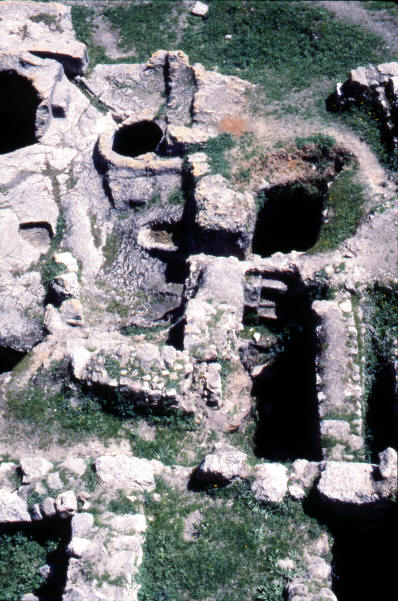
The traditional site of the high priest’s palace is about a 7 on our
scale of 1 to 10. This picture shows the ruins of the basement, looking
from above.
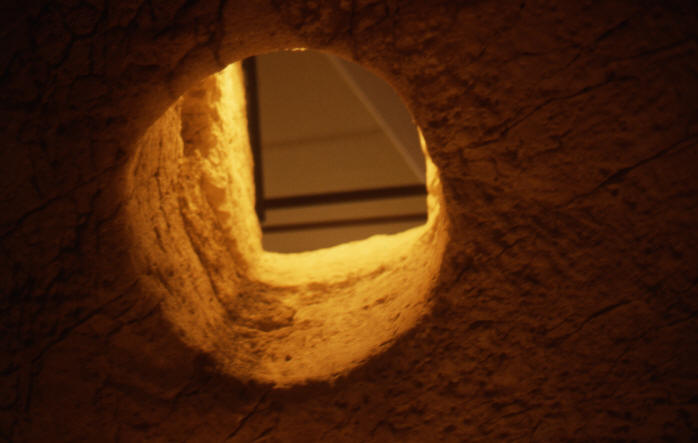
Included is a cave which served as a prison cell. Instead of bars
and a cell door, the prisoner would simply be lowered down through this hole,
and the ropes removed. Christ may have been held in this prison cell for a
time that night.
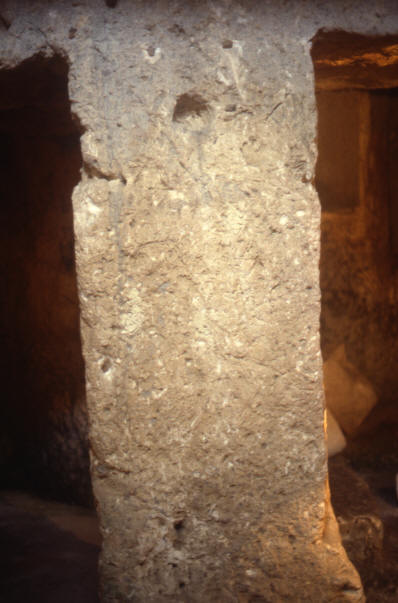
Nearby is this whipping post. Christ was not whipped at the high
priest’s house, but when he was savagely whipped early the next morning at
Pontius Pilate’s palace, he probably was tied, with his back exposed, to a
whipping post like this one.
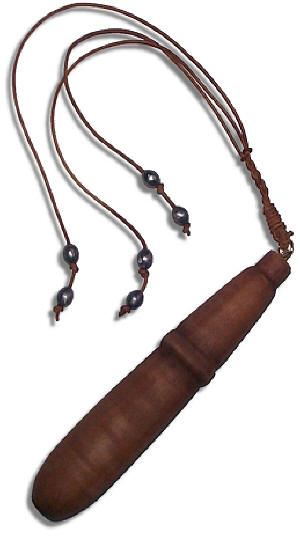
The victim would be brutally whipped with a special whip like this
called a “scourging whip,” with multiple strands embedded with sharp pieces of
broken pottery or glass.
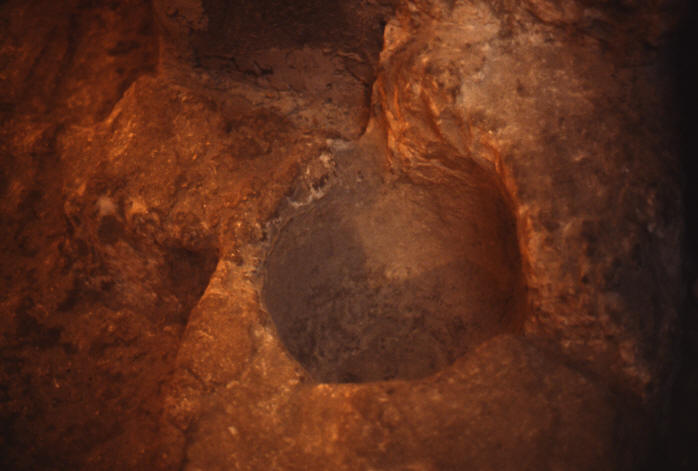
This little bowl carved into the floor near the whipping post shows the
perversity of mankind. For this bowl would be filled with saltwater into
which the whip would be dipped so that each lash would sting all the more.
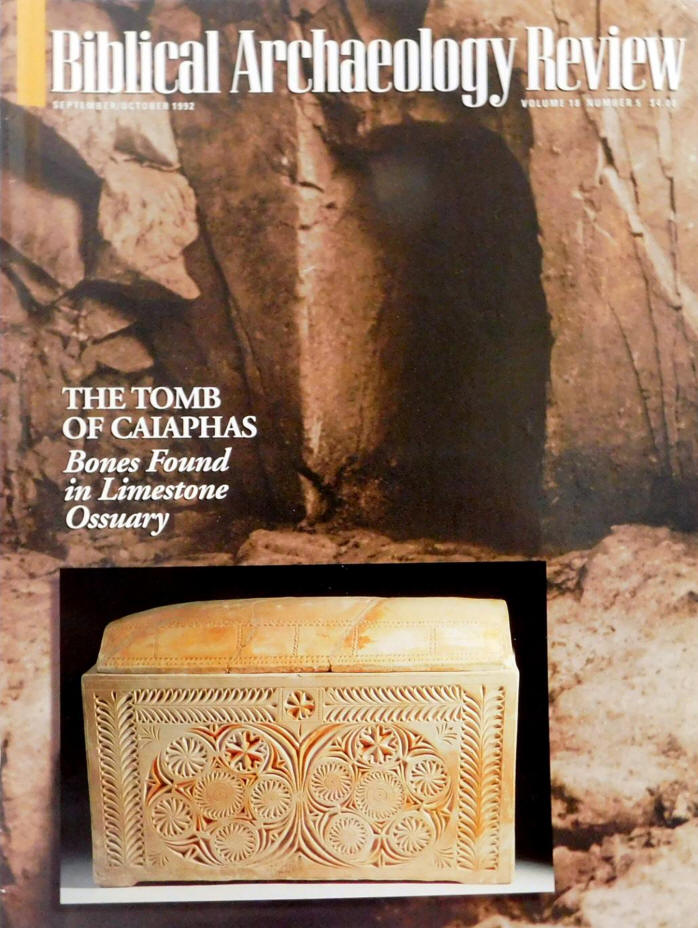
John reports, “The detachment of soldiers with its commander and the
Jewish officials arrested Jesus. They bound him and brought him first to Annas,
who was the father-in-law of Caiaphas, the high priest that year.” It’s
been said that, next to Jesus himself, we know more about Annas than any other
Israelite in the passion events. Years before, he had been high priest
himself, and he had schemed to have five of his sons, a grandson, and his
son-in-law Caiaphas all appointed high priest.
At one time, critics of the Bible asserted that many characters in the
Bible, such as Caiaphas, were only mythical and never really existed. But,
thirty years ago a condominium complex was under construction on the outskirts
of Jerusalem, and the bulldozer uncovered an elaborate burial cave. Inside
was a beautiful burial box inscribed with the name Caiaphas, pictured here on
the cover of Biblical Archaeology Review.
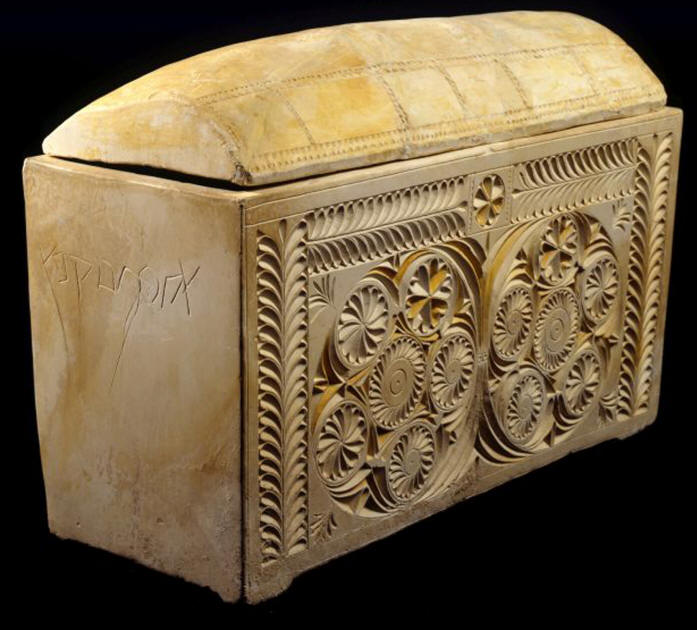
Most archaeologists agree this is almost certainly this is the burial
box of the very high priest under whom Jesus was tried.
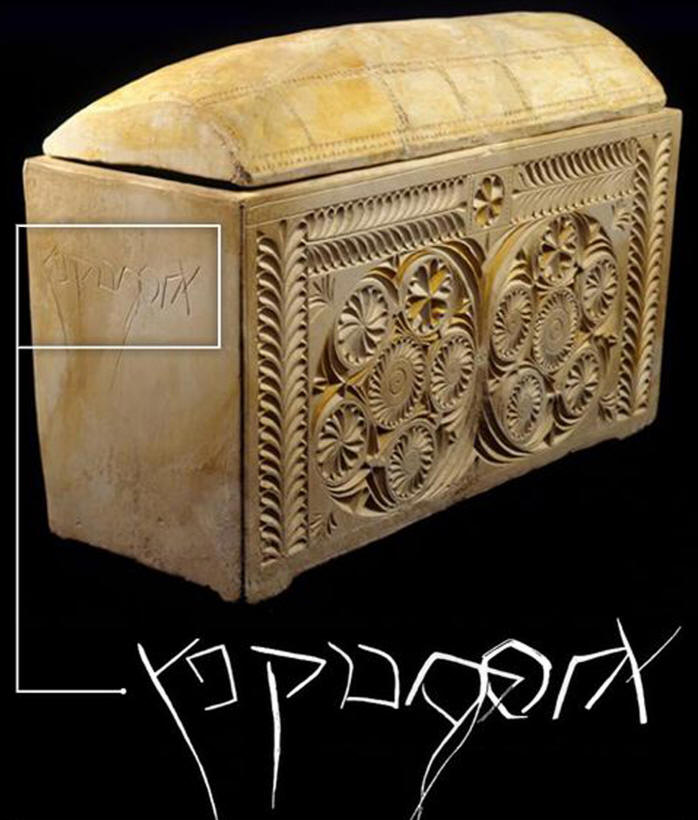
On the end of the box you can clearly see where it is inscribed in
Hebrew with the name “Caiaphas.”
John first tells us about the interrogation of Jesus by Caiaphas’
father-in-law Annas. Even though Annas was no longer the high priest
himself, John still refers to him as high priest, just as a former President
retains the title even after he as left office. John reports:
“Meanwhile, the high priest questioned Jesus about his disciples and
his teaching. ‘I have spoken openly to the world,’ Jesus replied. ‘I
always taught in synagogues or at the temple, where all the Jews come together.
I said nothing in secret. Why question me? Ask those who heard me. Surely
they know what I said.’ When Jesus said this, one of the officials nearby
struck him in the face. ‘Is this the way you answer the high priest?’ he
demanded. ‘If I said something wrong,’ Jesus replied, ‘testify as to what
is wrong. But if I spoke the truth, why did you strike me?’ Then Annas
sent him, still bound, to Caiaphas the high priest.”
By this time Caiaphas has assembled the Sanhedrin, the council of the
seventy elders of Israel. It’s in the middle of the night, perhaps two
o’clock in the morning. The Sanhedrin has be granted authority by Rome to
try minor cases, particularly matters of religion. Matthew reports:
“The chief priests and the whole Sanhedrin were looking for false
evidence against Jesus so that they could put him to death. But they did not
find any, though many false witnesses came forward. Finally two came forward and
declared, ‘This fellow said, “I am able to destroy the temple of God and rebuild
it in three days.”’
“Then the high priest stood up and said to Jesus, ‘Are you not going to
answer? What is this testimony that these men are bringing against you?’ But
Jesus remained silent. The high priest said to him, ‘I charge you under oath by
the living God: Tell us if you are the Christ, the Son of God.’ ‘Yes, it is as
you say,’ Jesus replied. ‘But I say to all of you: In the future you will see
the Son of Man sitting at the right hand of the Mighty One and coming on the
clouds of heaven.’ Then the high priest tore his clothes and said, ‘He has
spoken blasphemy! Why do we need any more witnesses? Look, now you have heard
the blasphemy. What do you think?’ ‘He is worthy of death,’ they answered.”
Jesus appeared before Sanhedrin once more, a few hours later.
Luke says “at daybreak”; Mark reports: “Very early in the morning, the chief
priests, with the elders, the teachers of the law and the whole Sanhedrin,
reached a decision. They bound Jesus, led him away and handed him over to
Pilate.” This second meeting of the Sanhedrin was necessary because it was
against both Jewish and Roman law for a trial to take place at night. So
at daybreak a “kangaroo court” was held to give a pretense of propriety to the
judgment actually reached the night before.
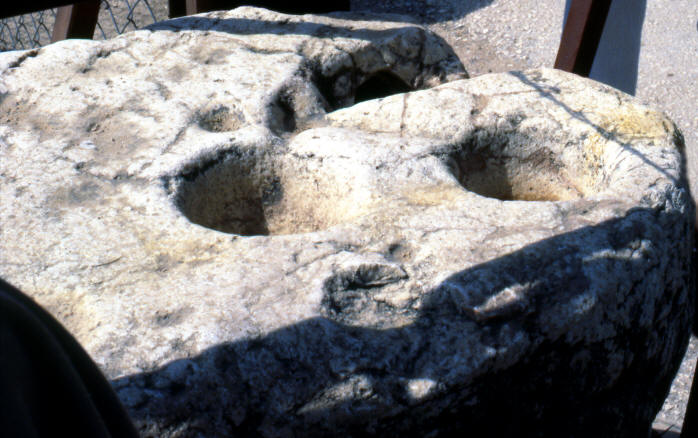
What motivated Annas, Caiaphas, and the Sanhedrin to conspire against
Jesus, a rabbi of their own people? You remember when Jesus drove the
money-changers and the merchants out of the Temple? This little
bowls carved into a stone outside the synagogue at Capernaum were for the money
changers there. Each bowl was like a partition in a cash drawer holding a
different denomination of coin.
The Temple had degenerated into a mere business, a very big business.
Concessions off the Temple made these men the richest and most powerful men in
Jerusalem. And that is why Annas and Caiaphas and the Sanhedrin conspired
against Jesus to kill him: money and power. They saw Jesus as a
rabble-rousing rabbi who threatened their money and power. Their
philosophy of life is called materialism: preoccupation with material and not
spiritual things.
Point #2) In the Judgment Hall of Hedonism
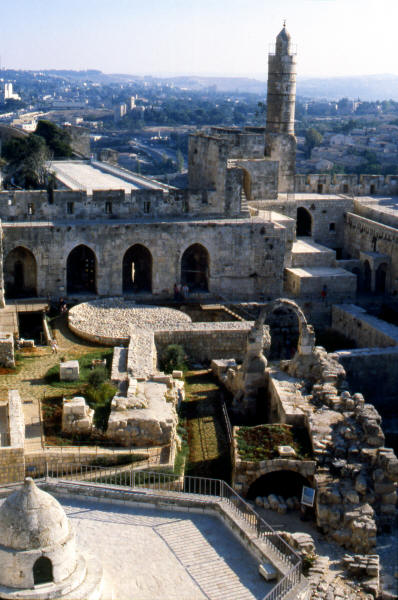
We confess in the Creed, “He suffered under Pontius Pilate.” When
Pontius Pilate was in residence at Jerusalem he lived in this palace, which was
originally built by Herod the Great. This is another 10 on our scale of 1
to 10. It is definitely the very place where “He suffered under Pontius
Pilate.”
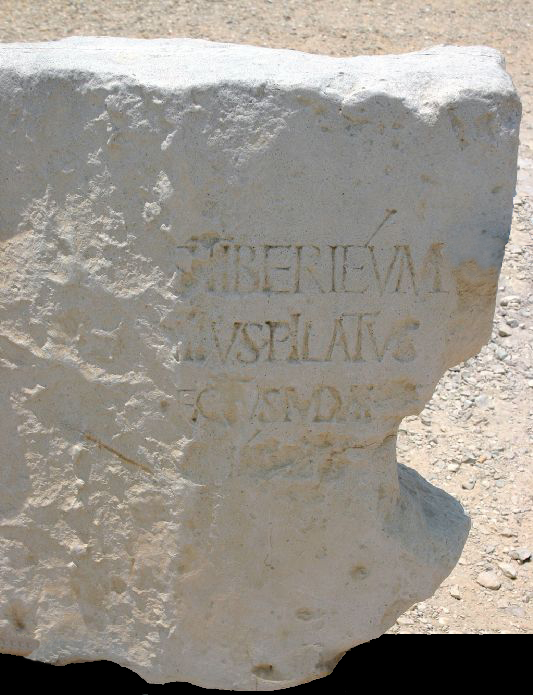
Pontius Pilate is another personage from the passion story that critics
used to claim didn’t actually exist. He was ridiculed by these skeptics as
a mere fiction, a mythical, fairy tale figure, made up by the early Christians.
Then in 1964 this dedication stone for a theater was uncovered at the port city
of Caesarea. The theater was called a “Tiberium” after the Emperor
Tiberius.
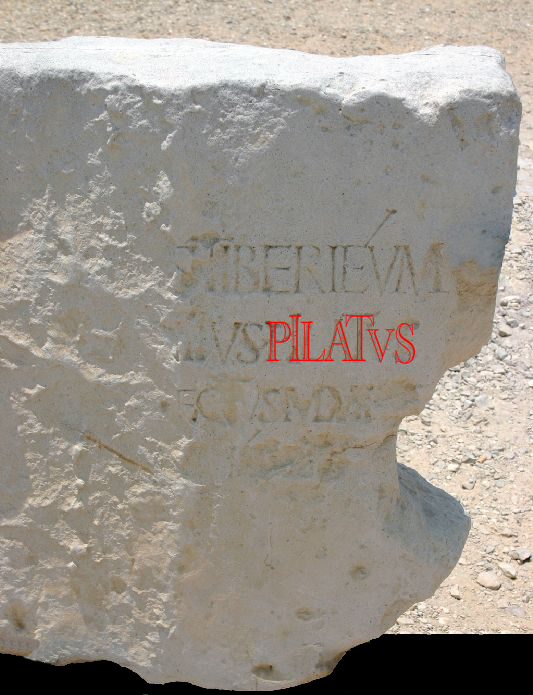
With Pilate’s name unmistakable, this dedication stone says: “This
Tiberium was Given to the People of Caesarea by Pontius Pilate, Prefect of
Judea.”
Jesus once said that “the very stones will cry out” in witness to him,
and this ancient stone cries out against the critics of the Bible, who claimed
Pontius Pilate never even existed. It cries out and confirms the
truthfulness and testimony of Scripture, as Paul says in 1st Timothy: “Christ
Jesus made the good confession in his testimony before Pontius Pilate.”
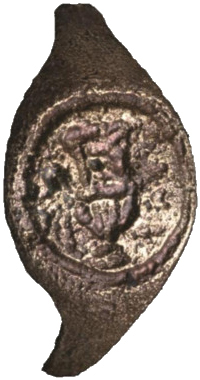
And just a few years ago yet another amazing confirmation was
discovered of the Roman ruler under whom Jesus suffered, and was crucified,
dead, and buried. This signet ring was actually discovered in 1969 at one
of the palaces used by Pontius Pilate and the other Roman governors of Judea,
but it was so corroded that the picture on it could not be revealed back then,
so it was put in storage and forgotten. Researchers at Hebrew University in
Jerusalem came upon it again by accident a few years ago when they were cleaning
out a storage room.
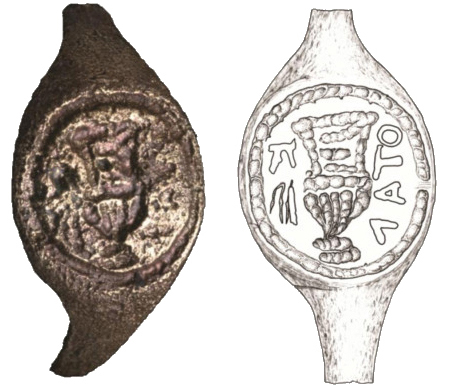
New cleaning techniques and computer-enhanced digital photography made
it possible for them to render the inscription crystal clear—and it turned out
to be not an obscure artifact, but an extremely important historic find!
For, around a wine vessel in the center of the ring is the possessive form in
Greek of the name “Pilate,” meaning “Of or Belonging to Pilate.”
Such rings were used for official business by Pontius Pilate’s
underlings. You may recall that the Gospel of Matthew reports that after
Christ was crucified, dead, and buried, Pilate commanded, “‘Take a guard and go
and make the tomb as secure as you know how.’ So they went and made the tomb
secure by putting a seal on the stone and posting the guard.”
It would have been a signet ring exactly like this one that was
impressed into the wax seal on the stone of Christ’s tomb. There were many
duplicates of this ring entrusted to Pilate’s underlings for official business.
However, this ring was found at a palace only ten miles from Jerusalem, so it is
possible this might have been the very ring that officially sealed Christ’s
tomb.
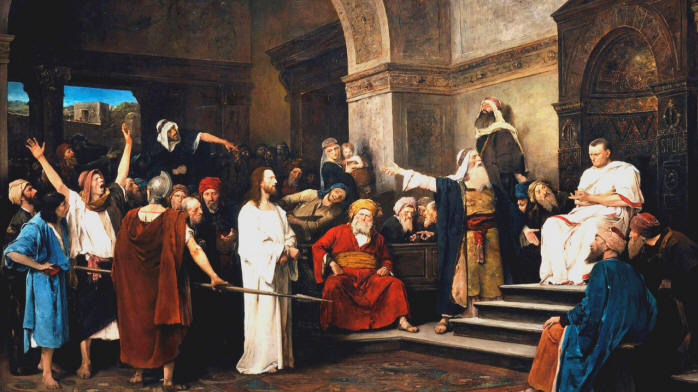
This painting of “Christ before Pilate” was painted by Hungarian artist
Mihaly Munkacsy in 1881.
Peter says in Acts, “You, with the help of wicked men, put him to death
by nailing him to the cross.” They had to have the help of the Roman
governor Pontius Pilate, for only he had the authority to execute anyone.
Time after time Pilate actually declares Jesus innocent: “I find no
basis for a charge against him . . . he has done nothing to deserve
death.” The centurion in charge of the crucifixion declared, “Surely this
was a righteous man.” Even the thief on the cross beside Jesus said, “This
man has done nothing wrong.” According to every tenet of Roman law Jesus
should have gone free, and the Gospels tell us Pilate wanted to release Jesus
and tried to set him free.
One of legal maneuvers he attempted to set Jesus free was change of
venue. Luke reports: “Pilate asked if [Jesus] was a Galilean. When he
learned that Jesus was under Herod’s jurisdiction, he sent him to Herod, who was
also in Jerusalem at that time. When Herod saw Jesus, he was greatly pleased,
because for a long time he had been wanting to see him. From what he had heard
about him, he hoped to see him perform some miracle. He plied him with many
questions, but Jesus gave him no answer. The chief priests and the teachers of
the law were standing there, vehemently accusing him. Then Herod and his
soldiers ridiculed and mocked him. Dressing him in an elegant robe, they sent
him back to Pilate. That day Herod and Pilate became friends—before this they
had been enemies.”
Herod Antipas could and should have set Jesus free, but he was
interested only in being entertained. His philosophy of life is called
hedonism: devotion to pleasure.
Point #3) In the Judgment Hall of Egoism
You remember the other maneuvers Pilate tried to set Jesus free: simply
declaring Jesus innocent; giving the crowd a no-brainer choice between Jesus and
Barabbas, a notorious criminal who was public enemy #1; Pilate even has Jesus
flogged in front of the crowd and dressed as a mock king because he hoped that
this humiliation would satisfy those insisting on his death.
But, to every one of Pilate’s maneuvers the Gospels report the same
reaction: “The chief priests stirred up the crowd . . . they kept
shouting, ‘Crucify him! Crucify him!’ . . . with loud shouts they
insistently demanded that he be crucified, and their shouts prevailed. So
Pilate decided to grant their demand. . . Finally Pilate handed him over
to them to be crucified.”
The Gospels give us two hints as to why a Roman governor would give
into a murderous mob. Palestine was the Siberia of the Empire, and Pilate
had been sent there as governor because of his previous snafus. This was
his last chance, and already there had been several runs-ins with the Jewish
leaders and a terrible riot once already at Passover several years before.
Now the Jewish leaders are actually threatening to accuse Pilate of treason:
“The Jews kept shouting, ‘If you let this man go, you are no friend of Caesar.
Anyone who claims to be a king opposes Caesar.’ When Pilate heard this, he
brought Jesus out and sat down on the judge’s seat.” And it looks like
there could be a repeat of that Passover riot that got Pilate into so much
trouble: “When Pilate saw that he was getting nowhere, but that instead an riot
was starting, he took water and washed his hands in front of the crowd and said,
“I am innocent of this man’s blood.”
What’s at stake is Pontius Pilate’s privileged position as one of the
rich and famous of the Roman Empire. To avoid trouble for himself, to
avoid a riot or charges of treason, he decides to put an innocent man to death.
His philosophy of life is called egoism: self-preservation—at any cost,
selfishly looking out for #1.
Like Annas, Caiaphas and the Sanhedrin, we too are guilty of
materialism: preoccupation with material and not spiritual things. Like
Herod Antipas, we too are guilty of hedonism: devotion to pleasure. Like
Pontius Pilate, we too are guilty of egoism: self-preservation—at any cost,
selfishly looking out for #1.
Scripture warns, “Man is destined once to die, and after that to face
the judgment . . . For we must all appear before the judgment seat of Christ.”
But the Good News is, Christ’s unjust condemnation in the judgment halls of men,
his unjust condemnation on account of human materialism, hedonism, and egoism,
earned for you freedom from condemnation before the judgment throne of Christ.
Return to Top | Return to Sermons | Home | Email Church Office